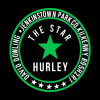Ash to the Clash
The Ash Tree
Ash is a hardwood that grows best on fertile, freely drained soils. Good soil and access to light allow ash trees to flourish. Growing ash trees requires regular maintenance to allow for optimum growth. This requires regular thinning as the ash tree grows to allow light to access the tree and promote growth. It is said that ash loves the sound of running water, therefore, ash planted near running water is said to grow best. Once an ash tree has matured to close to 30 years, they are then suitable for hurley-making.
Knocking the ash tree
Once an ash tree is mature enough it will be knocked. This can be done in one of two ways. In some cases, the full tree is knocked. This is achieved digging down around the soil surrounding the tree and cutting into the tree at the lowest possible point so as to find the turn of the root of the tree. This provides the turn in the grain you see on the bas of a hurl. Alternatively, trees can be topped at a height of 1.1 metres or 1.3 metres prior to digging around the root and cutting into the roots of the tree.
Quartering and planking Once the tree has been knocked the root is then brought to the sawmill where it is quartered prior to being planked. Ash planks are in and around 1.25” thick once planked.
Drying Process
The drying of planks can take place in one of two ways. Ash planks can be dried naturally. This process can take anywhere from 6-9 months depending on the time of the year. Alternatively, ash can be kiln dried. This usually takes about 14 days to complete. This process requires the use of a dehumidifier to remove the moisture from the air within the drying room and fans which circulate the air between the ash planks to remove moisture from the planks.
Marking
Once the ash has been dried in will then be marked up. This involves carefully selecting planks that are suitable for making each size and shape of hurl. This stage of hurley-making can take time and it is crucial to the production of hurleys of the highest quality.
Sawing
A this point of the hurley-making process hurls are sawn out to the shape prior to be sawn out by hand or prepared for machining on a lathe. Sawing a hurl by hand is a skilled process that takes time.
Spokeshaving
Spokeshaving is at the core of the craft of hurley-making and what links hurley-making in the early 1900’s to how we make our hurls today. Spoke shaving is what defines hurley-making from hurley manufacturing. The ability to make a hurl by hand is what makes hurley-making
a craft. Spokeshaving involves the use of a hand plane to ensure that the handle of the hurl runs straight from the handle to just above the heel of the hurl. Spokeshaves are then used to spokeshave the handle, bas, nose and heel of the hurl. Spokeshaving allows for the best finish on a hurl, and it allows each facet of a hurl to flow into the next. Spokeshaving increases the accuracy of the finish of the hurl in terms of meeting the requests of the hurler in terms of the thickness of the handle or heel of the hurl and the weight they require the hurl to be.
Sanding
Following the spokeshaving each hurl is given a light sanding which provides a top quality finish.

